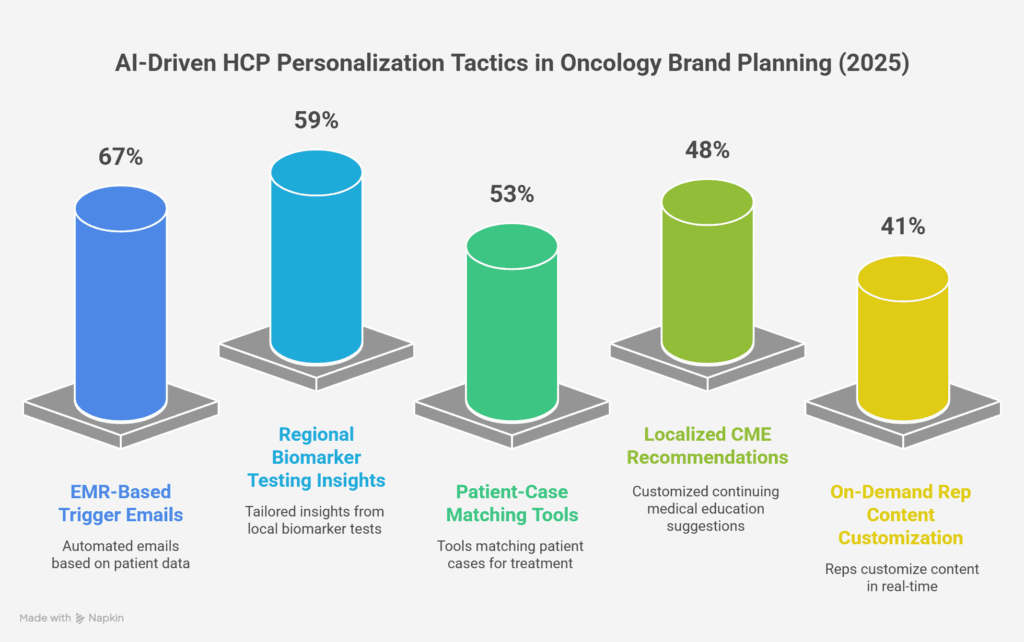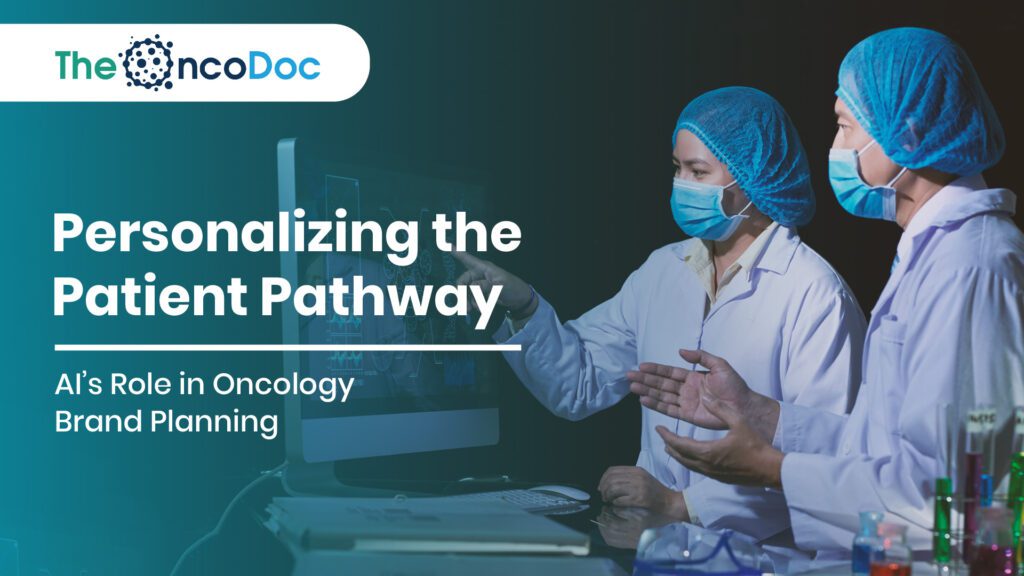Introduction: From One-Size-Fits-All to Precision Planning
In 2025, the age of personalization in oncology is no longer a prediction, it is an expectation. With the rise of precision medicine, biomarker-driven therapies, and patient-initiated digital engagement, the traditional linear marketing funnel has become obsolete. Pharma brands must now adapt to the non-linear, emotionally charged, and clinically complex journeys of oncology patients. And they must do so in real time.
At the core of this transformation lies artificial intelligence (AI), a powerful enabler that is reshaping how brand teams design, deliver, and measure impact across the oncology care continuum.
From identifying at-risk populations to delivering hyper-targeted educational content to HCPs, and from segmenting patients based on digital behavior to predicting therapy adherence risks, AI is redefining oncology brand planning. The focus has shifted from product promotion to personalized patient support, and pharma must meet that moment with intelligent, responsive, and ethical strategy.
This article explores how AI is helping oncology marketers map and influence the patient pathway, building more meaningful brand value and improving patient outcomes.
The complexity of oncology care demands more than conventional marketing, it requires empathetic orchestration. Each patient interacts with a web of decisions, emotions, and stakeholders, from diagnosis to survivorship or palliative care. Yet traditional brand planning often lacks the flexibility to accommodate this nuance. AI brings the intelligence and agility needed to interpret these variables in real-time.
What once required months of manual analysis is now being processed in seconds by AI algorithms scanning EMRs, physician notes, lab data, social listening platforms, and even wearable device inputs. The result? A more informed and responsive brand strategy that mirrors the personal nature of oncology itself.
1. Mapping the Oncology Patient Journey with Data Signals
The oncology patient journey is not a straight line. It involves multiple stages, pre-diagnosis, diagnosis, treatment initiation, switching, relapse, survivorship, and palliative care. These stages are shaped by factors like age, location, socioeconomic status, biomarkers, access to care, and psychological readiness.
AI tools, especially those trained on real-world evidence (RWE), EMR data, and claims analytics, are helping pharma teams decode these pathways with precision.
For example, AI can detect early signs of therapy drop-off by analyzing appointment cancellations, lab data trends, or patient portal inactivity. Similarly, it can identify referral bottlenecks by tracking how long it takes for a patient to move from biopsy to treatment.
This insight allows brands to intervene with the right support at the right time, be it educational content for patients, resources for caregivers, or tools for clinicians managing a rare biomarker-positive case.
2. Segmenting Patients by Behavior, Not Just Biology
Traditional segmentation focused on tumor type, stage, and biomarker status. But AI enables behavioral and attitudinal segmentation, offering deeper insight into patient needs and communication preferences.
Some patients, for example, are “digitally engaged”, actively using symptom trackers, participating in online forums, and reading clinical blogs. Others are “clinically dependent” ; relying solely on physician guidance and passive education. AI-powered clustering algorithms group patients accordingly, allowing pharma brands to create customized engagement strategies.
This goes beyond messaging. It influences channel selection, language tone, content depth, and even visual storytelling.
3. AI-Powered Persona Building for Oncology Brands
AI doesn’t just segment patients, it builds personas that guide brand strategy. A persona might look like:
- “Ravi, 49, KRAS-positive colorectal cancer, suburban India, limited internet access, passive decision-maker.”
- “Anjali, 35, TNBC, urban caregiver, bilingual, seeks second opinions via digital forums.”
These personas allow marketing teams to visualize target audiences more holistically. Content planning, patient support initiatives, and rep engagement strategies are tailored accordingly.
Some advanced AI platforms also integrate social determinants of health (SDoH) to fine-tune personas,factors like income level, education, and transportation access can alter therapy adherence and decision timelines.
AI doesn’t just replace manual segmentation, it enriches it. Using a blend of supervised and unsupervised learning, AI identifies hidden correlations that human analysts may miss. For instance, patients who delay treatment due to caregiving responsibilities may not cluster by tumor type, but by behavioral markers. AI connects these dots.
Moreover, personas are now dynamic, evolving with every interaction the patient has, be it a click on a symptom management article or a chatbot conversation about side effects. This living profile is constantly updated and used to personalize outreach, flag disengagement, or recommend tools like patient diaries or financial navigators.
For brand teams, this means moving beyond demographic assumptions and embracing adaptive storytelling, one that evolves with the patient’s condition, mindset, and context.
4. Predicting Pain Points Along the Care Continuum
With oncology journeys often lasting months or years, predictive AI models are used to forecast key drop-off points in the patient pathway:
- When might a patient discontinue therapy?
- At which stage is financial toxicity likely to occur?
- Which patients are at risk for late-stage diagnosis due to diagnostic inertia?
AI flags these friction points early, enabling pharma brands to proactively design interventions, ranging from co-pay assistance messaging and side-effect management tools to educational webinars for caregivers.
This forecasting capability changes the brand role from passive supporter to proactive navigator of care.
5. Personalizing HCP Engagement Based on Patient Data
Oncology brand planning isn’t complete without a deep understanding of the HCP landscape. AI enables HCP-level personalization by analyzing:
- Patient population types by practice
- Biomarker testing behavior
- CME participation patterns
- EMR behaviour and digital touchpoints.

This allows reps and brand teams to offer clinically timed, context-specific content. For instance, if an oncologist in Chennai frequently treats HER2-low breast cancer patients but hasn’t adopted a new ADC therapy, the brand’s CRM system might trigger a rep visit with data visualizations, patient case videos, and a CME invite focused on that exact mutation subtype.
6. Content That Evolves with the Patient
Static PDFs are a relic. AI-driven platforms now create dynamic, evolving content that adapts to the patient’s stage, condition, and sentiment.
For example, a patient newly diagnosed with non-small cell lung cancer may receive:
- A calming explainer video on diagnosis
- Followed by a Q&A chatbot answering biomarker questions
- Then, post-surgery, a dosing tool synced to their treatment plan
- And later, a survivorship planner in their native language
AI ensures that content flows with the patient, not ahead or behind them, creating a narrative experience that reduces anxiety, boosts confidence, and improves adherence.
7. Multilingual, Culturally Relevant Storytelling
With over 20 languages spoken across India and diverse patient backgrounds globally, localization powered by AI is essential.
Natural language generation (NLG) and translation models convert medical content into region-specific formats, complete with cultural cues, dialect sensitivity, and context-appropriate visuals. For example, AI translates “fatigue” not just linguistically but emotionally. What does fatigue feel like to a 70-year-old Gujarati woman vs. a 32-year-old Bengali male caregiver?
Brands are also building vernacular voice bots, WhatsApp support tools, and culturally nuanced animation videos to increase accessibility.
Advanced natural language processing (NLP) models can now translate and localize brand messaging in ways that go beyond literal word-for-word substitution. AI adapts tone, health literacy level, idiomatic expressions, and even culturally specific metaphors to make patient education and support materials more meaningful. For instance, a message around survivorship in rural India may focus on family resilience and daily routine, while in urban Germany it might emphasize treatment innovations and clinical autonomy.
Furthermore, AI-powered insights from social listening tools allow oncology brands to understand how different communities discuss cancer, what words they use for diagnosis, how they interpret side effects, and what concerns drive therapy acceptance or avoidance. This feeds into more empathetic storytelling that reflects real-world fears, hopes, and values.
By incorporating multilingual content across digital assets, from patient portals and email sequences to chatbot scripts and treatment explainers, pharma brands can ensure that no patient feels excluded due to language. The impact is measurable: higher engagement rates, improved comprehension, and stronger brand affinity.
Ultimately, culturally relevant storytelling is not just an inclusion strategy, it’s a clinical necessity in ensuring equitable access to information, informed decision-making, and positive treatment experiences across the cancer care continuum.
8. Ethical Use of AI in Patient Engagement
As brands gain access to more patient-level data, ethical governance is paramount.
Brands must ensure that:
- Data privacy is protected (HIPAA/GDPR compliant)
- Algorithms are bias-checked across race, region, and gender
- AI-driven outreach avoids emotional manipulation
- Content prioritizes education over promotion
Forward-thinking pharma teams are now including ethics leads in AI projects, conducting audits, and publishing transparency reports on how patient data is used.
Because trust is the currency of oncology engagement, and AI must earn it, not assume it.
AI’s power to personalize comes with a responsibility to protect, respect, and uplift the patient. As algorithms become more accurate in identifying emotional states, disease progression, or treatment hesitancy, there’s a risk that marketing oversteps into manipulation.
Ethical AI governance means more than compliance; it demands intention. Brands should:
- Clearly disclose when AI is used in patient-facing tools.
- Include human oversight in emotionally sensitive interactions (e.g., chatbot escalation for distress signals).
- Prioritize educational support over promotional nudges, especially when patients are making critical therapy decisions.
Additionally, pharma must ensure their AI platforms are trained on diverse datasets to avoid skewing insights toward a dominant demographic. Equity in engagement starts with equity in data.
Building trust through transparency will be a competitive differentiator for oncology brands in the AI age; because patients don’t just want smart systems, they want systems that care.
Conclusion: From Product Pipelines to Patient Pathways
In the new era of oncology marketing, success is no longer defined by reach or repetition, it’s defined by relevance and responsiveness. AI empowers brand teams to create living, learning, and listening strategies that grow with the patient, adapt to the clinician, and evolve with science.
By personalizing every step of the journey through intelligent segmentation, predictive planning, and empathetic content, pharma brands are no longer just delivering messages. They’re delivering value.
And in cancer care, value isn’t what you say , it’s how you show up.
The Oncodoc team is a group of passionate healthcare and marketing professionals dedicated to delivering accurate, engaging, and impactful content. With expertise across medical research, digital strategy, and clinical communication, the team focuses on empowering healthcare professionals and patients alike. Through evidence-based insights and innovative storytelling, Hidoc aims to bridge the gap between medicine and digital engagement, promoting wellness and informed decision-making.



